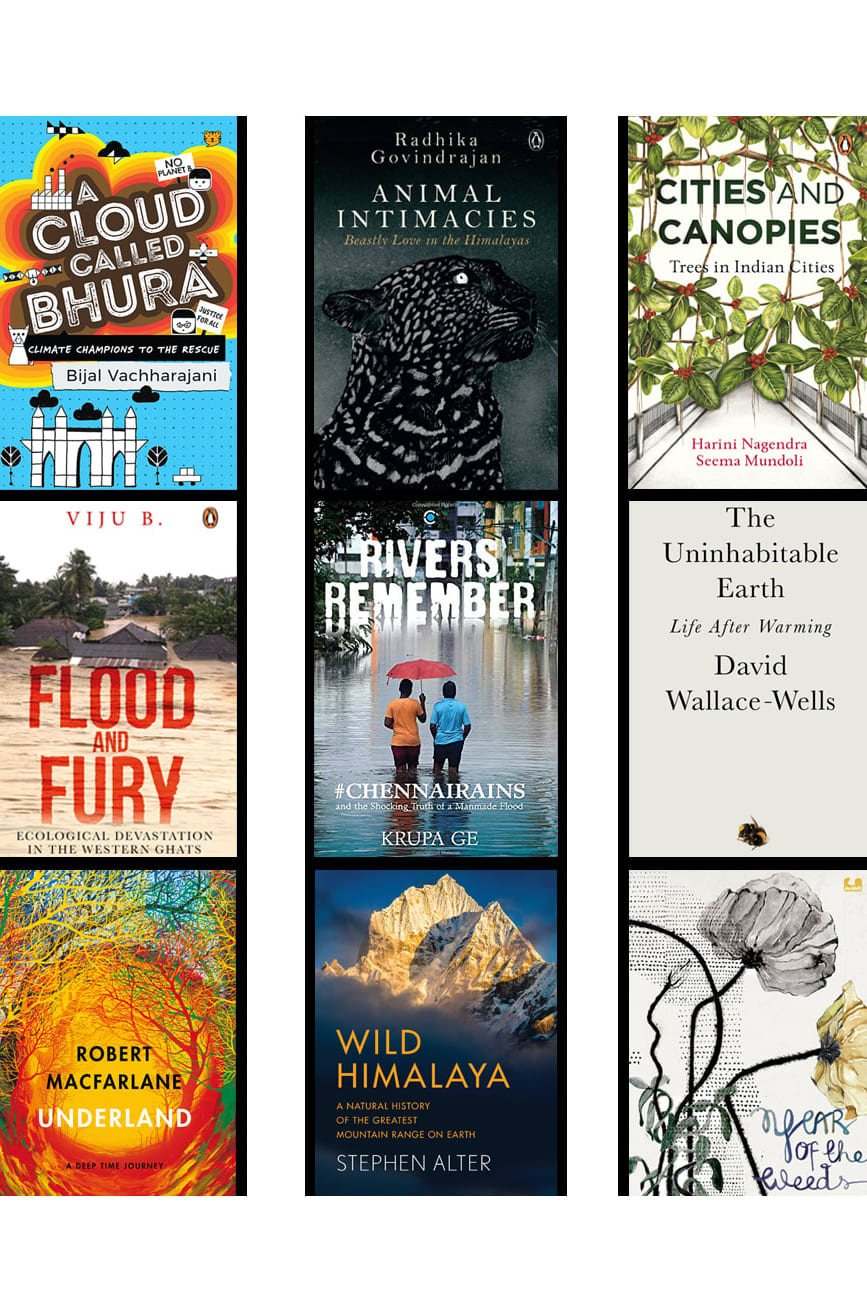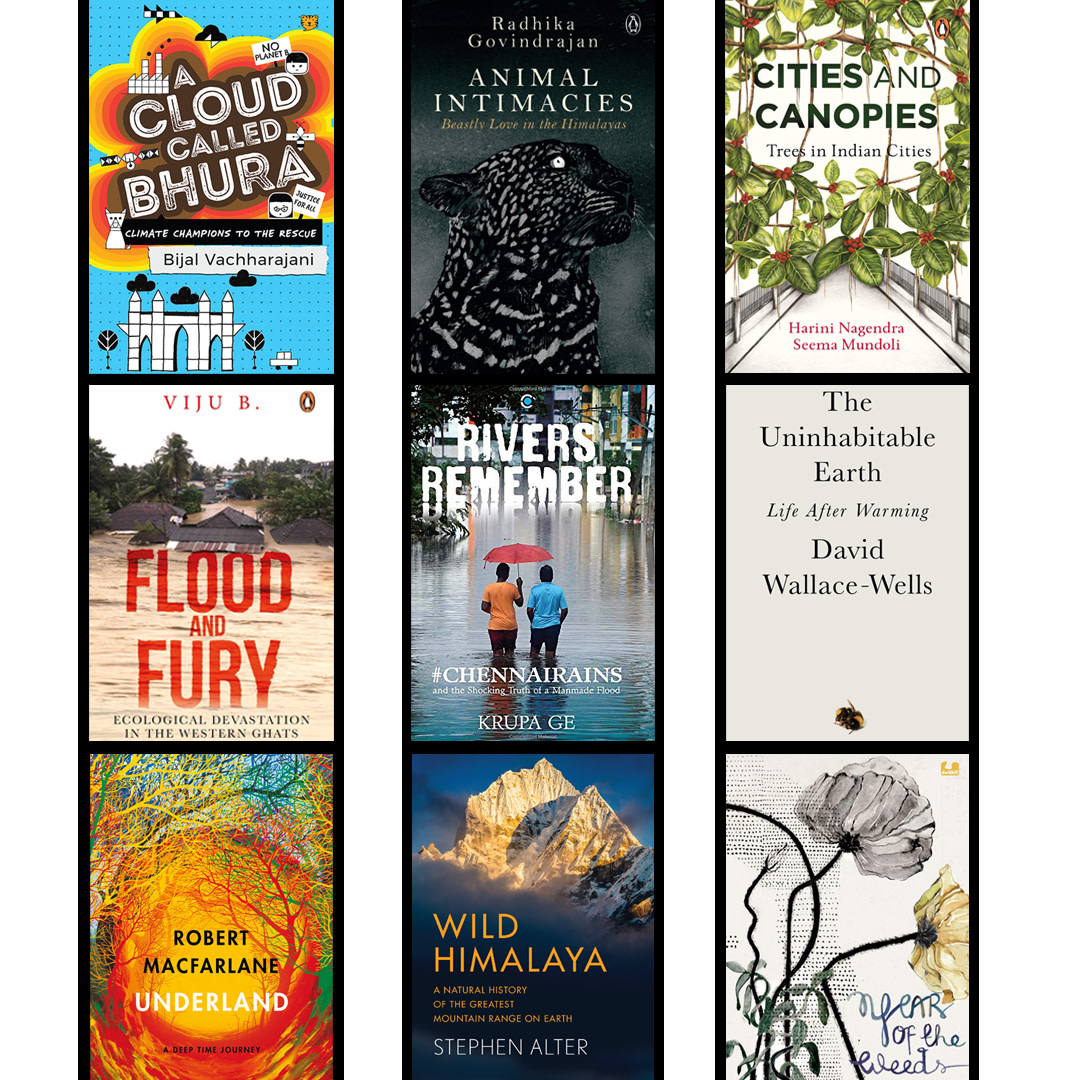 Listen to this article
•
15:34 min
Listen to this article
•
15:34 min
One of the best parts of my job, as a conservationist and writer on issues related to it, is the books I get to read, especially as my passion for the wilds has literary roots. In the days before Internet and Google — yes, I lived in strange times — books were my window to the natural world. I devoured book after book, travelling to Tanzania with Jane Goodall as she studied chimps (In the Shadow of Man), to Kenya with Joy Adamson in the exciting tale, Born Free, of living with the lioness Elsa, and to the enchanting Greek island of Corfu where Gerald Durrell led my dream life in My Family and Other Animals. I was inspired by Rachel Carson’s Silent Spring, and discovered that there was wildlife right in my backyard, with M Krishnan’s edited works Nature’s Spokesperson.
Reading on nature has been an enduring love affair, and as the year 2019 draws to a close, it’s time to reflect on the year’s environment reads, and to look forward to what the next year will bring. Given that life is not exactly “Ho ho ho!” on a planet stricken by the climate crisis and sixth extinction, such books may not ring in good cheer, and a few can be downright terrifying.

One such book is David Wallace-Wells’s The Uninhabitable Earth. When we think climate change, we struggle to comprehend its scale and scope. This is the go-to book to understand the planet’s most defining crisis. The clear, crisp prose starkly lays out the climate catastrophes that we can expect (soon): floods, droughts, food shortages, refugee emergencies, and other such suffering that will reshape the globe. “It is,” promises the author, “(far) worse than you think.” And no, you can’t wish it away. In some 200-odd pages The Uninhabitable Earth conveys the anxiety and urgency of the climate emergency, and the opportunity we (barely) have to seize the solutions for an inhabitable planet.
The other climate book I read is a complete contrast — it is for young adults and it’s fiction. Bijal Vachharajani’s A Cloud called Bhura is a response to Amitav Ghosh’s important question: Where is the fiction on climate change? asked in his classic The Great Derangement. Bhura is a nasty, toxic dark cloud that acid rains its lethal curses down on Mumbai: temperatures soar, crops die, the air gets foul, people wheeze, wither, choke; flamingos flee. As “groan-ups” and governments fumble, four young friends decide “We have to do something because no one else is doing anything.” Bhura is a commentary of our times. A brilliant, sparkling book written with gumption, it achieves that impossible task of making climate crisis-based fiction both worrying and fun read, even as it charges you to ACT.

It wouldn’t be fair to cherry-pick “best reads’ among young adult books, since I have read only a few, but I simply must mention (and you must read) The Year of the Weeds, a fiction book based on the Niyamgiri Hills, the biggest land conflict in recent times. Siddhartha Sarma’s story of the Gond resistance begins when the government informs them they will be uprooted from their sacred Devi Hills because of bauxite deposits beneath. This thoughtful, engaging tale is told from the point of view of Korok, a young Gond boy who is not in school because the school “left him,” when the teacher left. He cherishes the garden he tends to, in place of his father, who has been wrongfully imprisoned. And so, this beautifully told story gently tucks in between its many folds the everyday injustices meted out to the ‘invisibles’, communities like the Gonds in the hinterland. While others play a part, it is Korok and his fiery friend Anchita, a forest officer’s daughter, with the aid of her ‘Kompitar’ who plot the idea that derails the government plan of displacing the community for mining. This poignant story is essential reading, for young and not-so-young adults, more so at a time when our ailing democracy is going through not just a year, but an era of weeds.
Harini Nagendra and Seema Mundoli’s Cities and Canopies takes me back my childhood, reminding me of my friends who were trees, but who I lost along the way, as roads got wider and buildings, bigger. At a fundamental level this book is a khichdi of stories about trees — the most visible face of nature in Indian cities. It highlights some common city trees like the banyan, palm, tamarind, neem, peepul, silk cotton, amaltas etc., drawing on poetry, literature, myths, culture and science. In my review I likened it to a fresh, breezy cocktail — one that lifts your spirits, yet strikes a note of melancholy, rekindling lost loves and associations, kindling new knowledge and wonder, as it maps the ecological and cultural histories of trees in cities and in our lives, past and present. Read and reread this book on the place and importance of trees in our lives.

Two books that are vitally important to understand the links between the destruction of environment and the devastation caused during ‘unnatural disasters’ are Flood and Fury and Rivers Remember: The Shocking Truth of a Manmade Flood. In Flood and Fury journalist Viju B puts forward a solid case of how the ecological devastation of the Western Ghats for “development” caused havoc in 2018, with floods in Kerala (and Coorg, Karnataka) which claimed over 500 lives and caused huge economic losses, affecting nearly one million people. He also takes us through the mining that has ravaged Goa, and its equally beautiful and fragile neighbour Sindhudurg.
Rivers remember where they once flowed freely, and spread when swollen in the monsoons, but people, in their utter folly and sheer greed, forget. And don’t pay heed, continuing to madly construct and develop over the path of rivers, so the waters swell and swirl and destroy everything in their path. The heavy #ChennaiRains in 2015 were a natural disaster, but Ge’s book reveals how the magnitude of the destruction caused during the flood was man-made. Her prose is brutal. The journalist-author minces no words in holding truth to power. Yet her narrative is lyrical. She deftly weaves in stories (including her own) of people who suffered in the floods, and those who rose above their own tragedies to help others, lifting Chennai up from the muck and dredges of the rivers that give it life.
Both books are extensively researched and reveal the terrible state of urban planning (or mis-planning) and the hollowness, and horror of what we deem “development”.

We are reminded in Animal Intimacies that humankind’s relationship with nature is not entirely antagonistic, as it speaks of the fellowship between man and beast. Built on extensive ethnographic fieldwork in the mountain villages of Kumaon, Radhika Govindrajan’s book is lively reportage on life in mountain villages, where interaction with domesticated cattle and encounters with wild animals constitute a part of daily existence. “What does it mean to live a life that is knotted with other (non-human) lives for better and worse?” asks Govindrajan. Read this immensely fascinating book to find out.
My books of the year are ecological, geological, mythological histories and travelogues that explore the mountains that rise above the earth in Wild Himalaya, and the mysterious subterranean world beneath its crust in Underland.
Admittedly there is some bias in my choice of Wild Himalaya. I am not born to the mountains, but it is here, in the wilderness of the Himalayas, and the forests in its foothills (Corbett Tiger Reserve being a flagship) that I feel most at home. That said, the book is a monumental and remarkable piece of work that traverses the mountains across Pakistan, India, Nepal, Bhutan, and China. Says Stephen Alter who has spent most of his life in the Himalayas: “I wanted to tell the life story of the mountains.” And he has, elegantly braiding together on-the-ground reports with a deep understanding and study of the history, science, geology, environment, flora, fauna, myth, folklore, spirituality, climate, and people of the region. Personal stories are woven into the narrative and the author’s affection and affinity for the Himalayas shines through. The other strong thread that runs throughout is ecological concern for the vanishing biodiversity and cultures of the mountains.
Similarly, the culture of the Anthropocene is central to Robert Macfarlane’s Underland, shadowing each word and experience. “Are we being good ancestors?’’ questions the author-academic-explorer. When considering environmental damage, we usually think deforestation, pollution, desertification and so forth. What Macfarlane unearths, and brings into sharp focus, is how the reach of human activity extends, perhaps even more destructively and pervasively, underground — the bedrock of all life. He plunges deep inside the earth’s crust into caves, catacombs, mines, streams, and whirlpools mapping new geographies of knowledge. Macfarlane structures the book broadly in three competing, if overlapping, uses that humans have for the innards of the earth: “to shelter what is precious, to yield what is valuable, and to dispose of what is harmful.” Underland reflects Macfarlane’s fascination with language, illuminating unseen dark worlds with lyrical, haunting, compelling prose. The book has shifted my perception of the world, given me new direction and vision to both marvel at and worry about the world below my feet.
I err in classifying the above as “environmental” reads, each is a reflection of the natures within us, our intimate connections to, and dependence on nature, and the poignant withering of such ties that are damaging the environment, reshaping Planet Earth.
Note: Other notable books on my still-reading, and to-read 2019 books are The Wild Heart of India by TR Shankar Raman, Rewilding by Bahar Dutt , Greta Thunberg’s pamphlet No One Is Too Small to Make a Difference, Barry Lopez’s Horizons, and Are We Smart Enough to Know How Smart Animals Are? by Frans de Waal; The Girl and the Tiger by Paul Rosolie.







